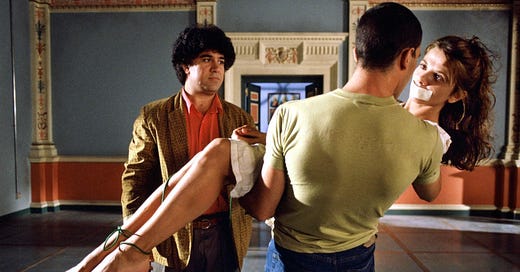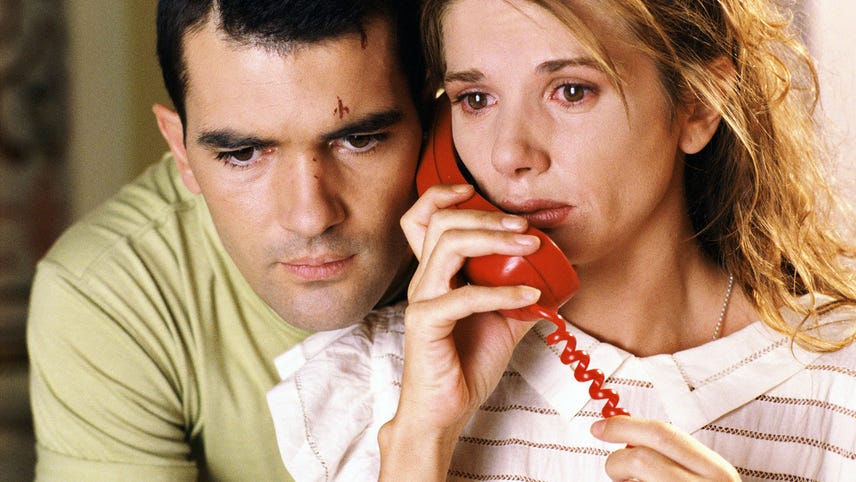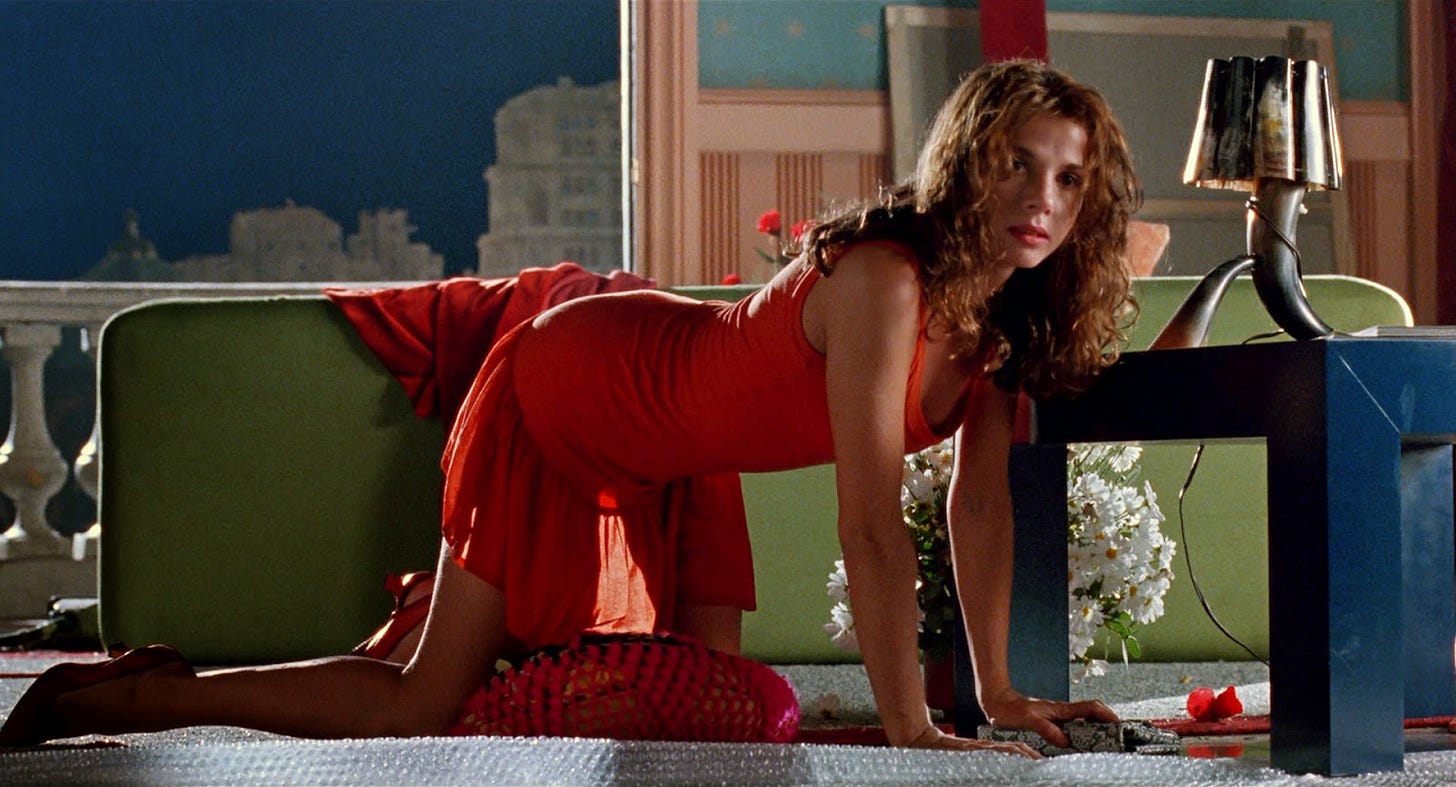The Movies That Inspired The Bombshell with Darrow Farr: Tie Me Up! Tie Me Down!
How did Pedro Almodovar's classic film inspire the instant-classic novel?
Last week, Pamela Dorman Books published The Bombshell, the highly anticipated debut novel from Darrow Farr. To commemorate the book’s release, The Best Movie Substack invited Darrow to participate in a multipart Q&A series about five major films that inspired her “towering literary achievement.” This week’s film is Pedro Almodovar’s Tie Me Up! Tie Me Down! (1989), which is currently streaming on The Criterion Channel. You can learn more about Darrow’s novel and this ongoing series by clicking this link. The IMDB synopsis of Almodovar’s film is below.
The Movies That Inspired The Bombshell with Darrow Farr
Part One: Tie Me Up! Tie Me Down! (1989)
Directed By: Pedro Almodovar
Synopsis: An unbalanced but alluring former mental patient takes a porn star prisoner in the hopes of convincing her to marry him.
~~~
CP: Let’s begin with the most obvious parallel between these two twisted romances: Both The Bombshell and Tie Me Up! Tie Me Down! revolve around the fluctuating power dynamics of a kidnapping. Like Almodovar’s film, the initial seriousness of The Bombshell’s inciting incident—the threat of physical and sexual violence on the part of the male kidnapper, the kidnapped woman’s fear and anger, and her desperate desire to escape—gradually evolve into an arrangement that’s much more complicated in terms of character psychology, gender performance, and the ritualized natures of courtship, seduction, and romance.
As Ricky, Antonio Banderas’s character, says to the target of his kidnapping, Marina, “I needed to kidnap you so you could get to know me,” and I think your book consciously dials into how that line can be read as unsettlingly scary, endearingly earnest and devotional, and even silly-sweet. Can you elaborate on how Almodovar’s approach to “the kidnap plot” inspired your own deployment of it in The Bombshell? How does Bruno’s kidnapping of Séverine compare and contrast with Ricky’s kidnapping of Marina?
DF: I actually didn’t watch Tie Me Up! Tie Me Down! until after I’d completed a draft of The Bombshell. But in revisions, I was struggling with the transition from Bruno as antagonist to Bruno as love interest, so I sought out movies where a hostage falls in love with their kidnapper (apparently this is a robust genre). Buffalo ’66 is also iconic, but Tie Me Up! Tie Me Down! most closely replicated the humor and eroticism I was trying to capture in Séverine and Bruno’s dynamic.
Initially, Bruno was rougher and colder towards Séverine, but that made it hard to thaw him to the point where the reader would eventually root for him and Séverine to get together. In Tie Me Up! Tie Me Down!, we’re endeared to Ricky from the first scenes, when we learn he’s not only very sexy, but handy, artistic, a bit guileless, and a tremendous lover. The young mental patient seducing the older asylum director is like a mini porno premise within the larger porno premise of the film.
That said, there are scenes when Ricky is genuinely menacing or violent. Sometimes Banderas has this totally innocent, open, boyish face, and other times it darkens and we can imagine how he landed in that asylum. Then Almodóvar will subvert that threat of violence, like when Marina goads Ricky to get her rape over with, and he responds, “We’ll fuck when the time comes.” Titillating—sweet even!
You noticed I borrowed a line from Ricky, when he hits Marina after breaking into her apartment: “I didn’t mean to hurt you, but you started to scream.” Bruno says something similar after he hits Séverine during her kidnapping. It was instructive to see how violence almost always coexists with tenderness and the erotic in Tie Me Up! Tie Me Down!. The big difference between the two kidnappings is that Ricky kidnaps Marina to make her fall in love with him, whereas that’s an unanticipated effect of Séverine becoming Bruno’s hostage. I’ve said a bunch of times that Séverine embodies the “rebel in search of a cause” that Patty Hearst was accused of being, but she’s also a lover in search of a beloved.
CP: Great answer. Maybe there’s more to be said about how your novel and Almodovar’s film manipulate the kidnap plot not just to experiment with genre, but to illustrate how the intoxicating intensity of the stories’ central romantic relationships allows an artist and their characters to disregard typical creative, moral, and political conventions. At turns, the genre of Tie Me Up! Tie Me Down! scans as soap opera, thriller, porno, horror, meta-horror, camp comedy, fairytale, and sometimes all of the above. For me, Almodovar’s generic playfulness works to reflect the tumult of thoughts and emotions that Ricky and Marina are experiencing, and I don’t think their union at the end would feel earned or authentic in a more straightforward movie. Do you see genre operating in a similarly hard-to-define way in The Bombshell?
DF: I do; when I first started writing The Bombshell, I conceived of it as a dark, comic romp in the vein of Almodóvar’s Women on the Verge of a Nervous Breakdown or Palindromes by Todd Solondz (both of which feature young women in love affairs with terrorists, I’m realizing). But I quickly understood I had to meet the characters on their level and allow them to be earnest in their ideologies, desires, and vulnerabilities. The novel ended up striving for a late-period Almodóvar vibe, like how Parallel Mothers is very sincere about its high-concept, melodramatic premise of babies being switched at birth.
From the get-go, I’ve thought of The Bombshell as “my young adult novel,” and throughout the publication process, there was a lot of talk about the book straddling commercial and literary genres. Hopefully, that means it’s fun and frothy but also well-written and thought-provoking. I think of my ideal reader as a precocious teenager who’s too mature for John Green but unexcited by the idea of Jane Austen. I do think you’re right that in order to pull off a story about a teen girl who is kidnapped, then seduces her kidnappers and takes over their revolutionary cell, genre play was necessary. It’s not a “realistic” book, and the main character is certainly not “normal” or entirely “relatable.” By incorporating aspects of thrillers, romance, and YA, the book signals to the reader that they should buckle up because they’re going on a ride.
CP: Compelling response. Building on that, it might be generative to talk about how Marina and Séverine are alternately empowered and constrained by their femininity. In Almodovar’s film, Marina is a kind of fallen woman, a former junkie and soft-core pornstar who sleeps under a print of the Virgin Mary, and is thus valued and devalued by the men around her. Séverine’s youth and outsider status, as a Parisian in Corsica, colors her male kidnappers’ perceptions of her. Although both women will ultimately assert their agency, Marina and Séverine reach starkly different places—in their lives and in their relationship with their kidnappers—by the end of their stories. Do you see Marina’s femininity as a model for Séverine’s? Why or why not?
DF: Not necessarily; Marina seems to feel constrained by her femininity and sexuality—she’s trying to transition into a “real” acting career but is being ogled and harassed by her annoying, horny director. On the other hand, Séverine is wielding her femininity and sexuality with pleasure; it’s still new to her as a teenager, and although she’s had some unsavory experiences, she’s not yet jaded.
Marina also expresses the desire to be protected by a man. Esther Perel famously talks about the need for security and risk in a relationship, and Ricky offers Marina both, simultaneously. Danger and safety are two strands of the rope that binds them, and something similar is going on between Bruno and Séverine—danger is inherent to the kidnapping and the bombings they carry out, but there’s safety in the bergerie, their conversations, and the way they feel understood by each other. At the same time, when Séverine is kidnapped, she quickly realizes she can be her own protector, and as the novel progresses, Bruno’s protector, or rather, the protector of his revolutionary vision. The gender dynamics at play are a little less conventional.
CP: Love it. On that note, Tie Me Up! Tie Me Down! and The Bombshell seem to approach taking someone hostage—and the courtship process in general—as a period in which the rigid rules of conduct and morality are suspended (or at least rendered more debatable and elastic). As the connection between Ricky and Marina matures, their interactions take on a surreal domesticity, with Ricky kindly venturing out to buy heroin for an ailing Marina, who tends to his wounds after he gets his ass kicked by drug dealers. The Bombshell takes it one step further by extending the stakes beyond the personal, as Séverine, Bruno, and their separatist cell carry out acts of political violence that have fatal consequences for bad actors and innocent bystanders alike. How did the context of Séverine and Bruno’s acts—the inherent irrationality of romance and politics—inform the construction of these characters and their choices?
DF: I went into the novel thinking the love story would be the irrational motor and the group’s politics would be the rational application of their folie à deux. That is, Bruno and Séverine’s desire would cause them to become more and more extreme in their political violence, and their comrades and the whole movement would be the collateral damage of their “cum brain1” as you, Carmen, might call it. But it became apparent that there was an emotional core to each character’s political formation, too, (duh!) that would cause them to make emotional decisions in the field.
I leaned into assigning each of the men a trope: Bruno is the colonized intellectual, Petru is the soldier, Tittu is the acolyte. So a desire for belonging, legitimacy, dignity, and camaraderie inform their actions and interactions, sometimes to the detriment of their political goals. However, I think the novel ends up arguing that love is a powerful catalyst for societal change (also duh!)—that if we care about the people we’re fighting with and for, the movement will be stronger for it. I’m getting a little corny, but basically we bring our bullshit to everything we do, so the idea of writing an honest novel about real characters who also have perfect politics and are always good people is…totally unreasonable.
CP: Wow. If we can get a little meta with the last question, how do you think “the kidnap plot” works allegorically? As we were rewatching Tie Me Up! Tie Me Down! and discussing it in relation to The Bombshell, I was curious whether these kinds of narratives might proliferate in the post-COVID era, dramatizing a high-stress period during which the status quo was abruptly disrupted and billions of people were stuck inside, fearing for their health and safety, for a seemingly indefinite period of time.
In a more macro sense, the kidnap plot mirrors the literary aesthetic experience, with the writer imposing their consciousness onto the reader until, hopefully, the reader becomes conditioned to enjoy being messed with, manipulated, subjugated, held captive; “the bird falls in love with its cage.” Was the experience of quarantine on your mind at all when you were writing and editing The Bombshell? And would the ideal “reader response” to The Bombshell mirror Séverine’s response to her kidnapping?
DF: Yes, of course—I want the reader to catch their own case of Stockholm syndrome, to root for Soffiu di Libertà and Bruno and Séverine as a couple, and to gleefully anticipate their acts of violence, even as they may feel discomfited or frustrated by the characters. And quarantine was forcibly on my mind—I was working on a second draft when COVID hit, and ended up taking a pretty long break, maybe about four or five months, because quarantine sapped my will to write. I need to socialize in order to sit in front of a computer for hours on end; there must be a balance between real life and imagined life, and that first year of COVID largely felt like imaginary life.
I was kind of horrified to realize that keeping my characters cooped up in the bergerie was a sort of quarantine—everyone was bored at home, so wouldn’t it be boring to read about people stuck in one place?—and subsequently tried to get them out of the house as much as possible. But my agent encouraged me to let them simmer at the bergerie, and insisted the conditions were ripe for interpersonal drama, for the characters to discover each other. I think that ended up being true, but by Chapter Four both Séverine and I got too antsy to stay there any longer. When they sneak out to the beach club after their first bombing, I channeled that free, relieved feeling of our first night out post-vaccine at the Avalon Emerson set on the Moshulu. :)
Want To Watch and Read Along at Home? Next Week’s Movie That Inspired The Bombshell Will Be: Eric Rohmer’s La Collecioneuse (1967).
Cum Brain : Trademark : Carmen Petaccio, 2025







